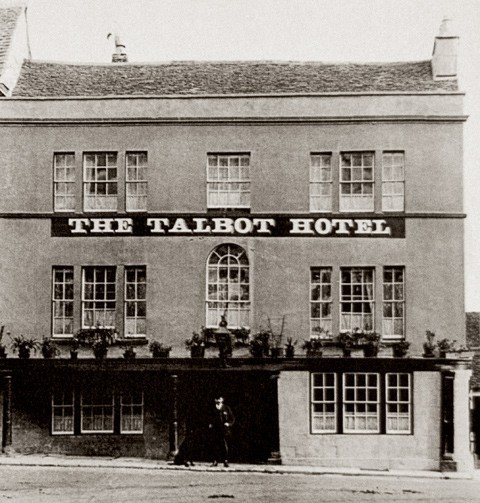
Photograph of the Talbot Hotel, Tetbury, England, ca. 1910. Edwin Webb, the landlord and captain of the Tetbury Fire Brigade is in the foreground. (Courtesy, Peter Williams.)
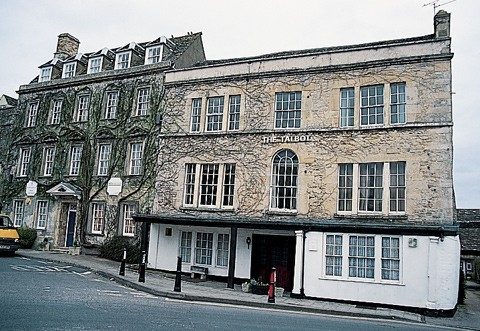
The Talbot Hotel today. (Photo, Peter Williams.)
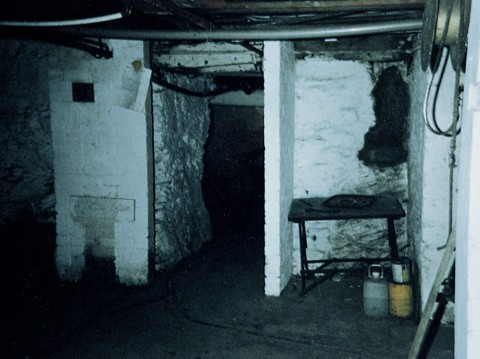
A view of the cellar in the Talbot Hotel where archaeological excavations revealed the late seventeenth- and early eighteenth-century refuse deposits. (Photo, Peter Williams.)

A selection of archaeological objects exhibited at the Corinium Museum shortly after their recovery. (Courtesy, Peter Williams.)
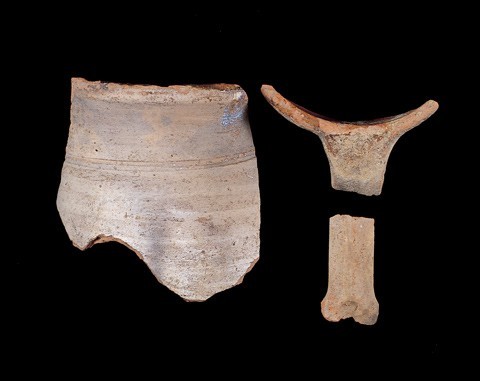
Fragments of a pitcher or chamber pot, England, ca. 1680. Lead-glazed coarse earthenware. ( All artifact photos by Gavin Ashworth unless otherwise noted.) These fragments represent a vessel with a rounded body and an internal mottled olive-brown glaze. The flared lip has traces of pinching, and the unglazed exterior has a wheel-turned double-grooved shoulder-band. The handle upper junction is at the lip, the lower junction with a thumbed attachment. Excavated evidence shows that chamber pots were not always used in the generally suspected manner. Many unearthed examples show signs of having been heated, as if they had been used for cooking purposes.
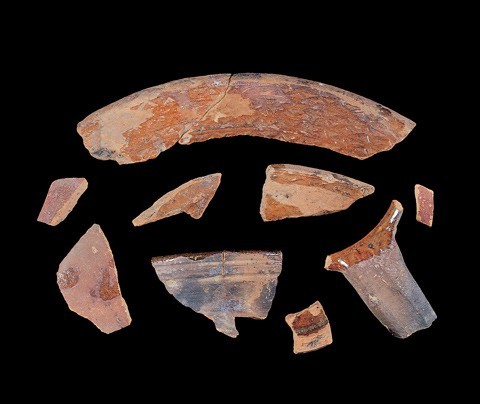
Various fragments, England, ca. 1680. Lead-glazed coarse earthenware. Diameter of this dish is estimated to be 16 3/4". The flange of this large dish has a rouletted, relief border of at least five concentric bands of zigzags reserved within concentric line borders. The upper surface is glazed. Fragments of various other vessels, including part of a lip with a wheel-turned, double-grooved band; part of a handle; and a small base fragment were recovered.
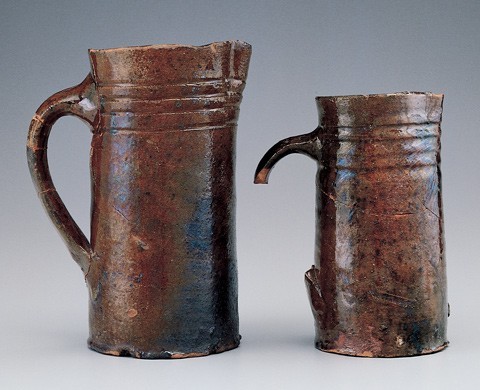
Jugs, Ashton Keynes, North Wiltshire, England, late seventeenth century. Lead-glazed coarse earthenware. H. 7 1/4" and 6". These jugs have a mottled olive-brown glaze on a tall, cylindrical body. The rims have been pinched to create pouring lips. The shoulder-bands are formed by wheel-turned grooves. The flat, circular bases are unglazed except for slight glaze flooding.
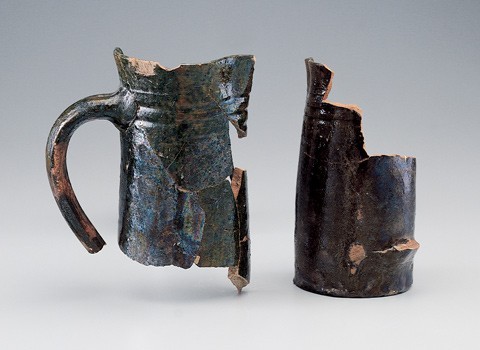
Jug fragments, Ashton Keynes, North Wiltshire, England, late seventeenth century. Lead-glazed coarse earthenware. H. 5 3/4". These fragments are from jugs with tall, cylindrical bodies with lip-pinch and shoulder-band formed by wheel-turned grooves. The jug on the left has a green glaze fired with a lustrous metallic appearance. The other has an olive-brown glaze, also fired with a lustrous metallic appearance. The flat, circular base is unglazed except for slight glaze flooding.
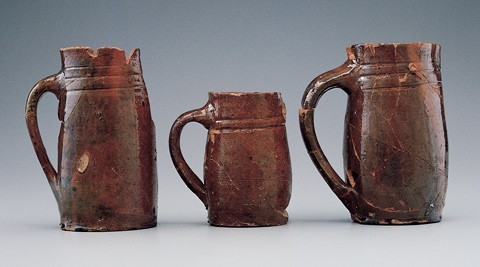
Jugs, Ashton Keynes, North Wiltshire, England, late seventeenth century. Lead-glazed coarse earthenware, H. 6 3/4", 5", and 6 1/2". These three jugs, each with a mottled olive-brown glaze, have slightly rounded, tall, cylindrical bodies. The flat, circular bases are unglazed except for slight glaze flooding. The jug on the right has a pinched lip for pouring.
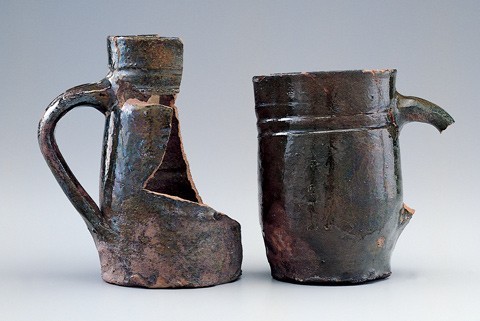
Jugs, Ashton Keynes, North Wiltshire, England, late seventeenth century. Lead-glazed coarse earthenware. H. 5 1/2" and 4 5/8". Examples of two jugs with a mottled green glaze. The flat, circular bases are unglazed except for slight glaze flooding. The jug on the right has a pinched lip for pouring.
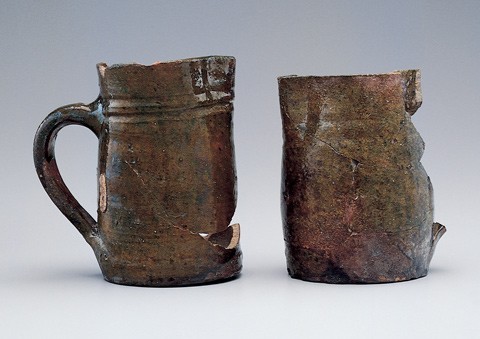
Jugs, Ashton Keynes, North Wiltshire, England, late seventeenth century. Lead-glazed coarse earthenware. H. 4 5/8" and 4 1/4". These jugs have a mottled green glaze on a slightly rounded, tall, cylindrical body with pouring lips. The flat, circular bases are unglazed except for slight glaze flooding.

Jugs, Ashton Keynes, North Wiltshire, England, late seventeenth century. Lead-glazed coarse earthenware. H. 5". These three jugs have a mottled, olive-brown glaze, although the glaze on the central jug has fired with a slight luster. The glaze on the far right jug has fired with a metallic lustrous appearance. Its base is also covered with glaze. The flat, circular bases of the other two jugs are unglazed except for slight glaze flooding.
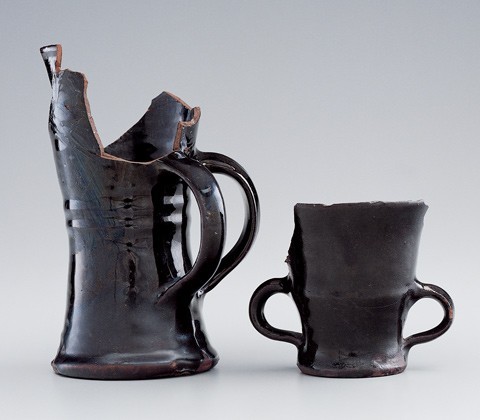
Mug and cup, Staffordshire, 1660–1680. Lead-glazed red earthenware. H. 6" and 3 1/8". The waisted mug on the left has a cylindrical body with two cordons around the middle. The slightly concave, circular base is unglazed except for slight glaze flooding. There are three clay-pad marks, one mark having glaze and clay adhesions. The two elongated loop handles are set at approximately twenty-two degrees to one another, attaching above the waist and midway between the waist and base. The cup illustrated on the right has a flared, cylindrical body with a rib encircling the waist. The base is unglazed except for slight glaze flooding, and there are two clay-pad marks. Base and handle fragments of another mug, or mugs, were also found each similar to the recovered beaker-shaped mug.
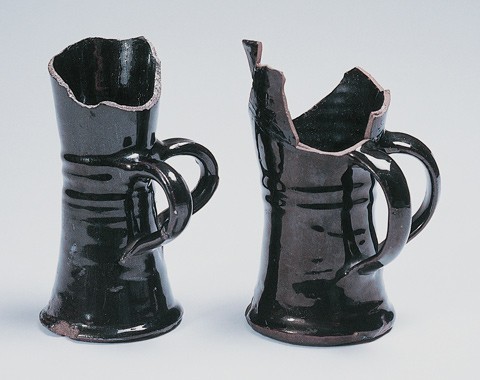
Mugs, Staffordshire, 1660–1680. Lead-glazed red earthenware. (The example on the left courtesy, Potteries Museum.) Similar vessels are commonly found in excavations in the Stoke-on-Trent area and on numerous other sites throughout Great Britain.

Mug fragment, Staffordshire, 1700–1720. Manganese-mottled earthenware. (Courtesy, Potteries Museum.) Applied, or sometimes impressed, ale-measure marks are commonly found on “mottled ware” tavern mugs, these bearing the initials of the reigning monarch, namely “WR” for William III, “AR” for Queen Anne, and “GR” for George I.
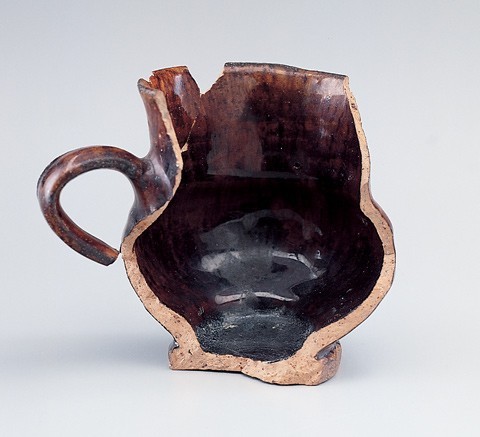
Cup, Staffordshire, 1700–1720. H. 2 7/8". Manganese-mottled earthenware. This “thistle” shape cup has a compressed spherical body, a flared cylindrical neck, an unglazed short cylindrical foot and an unglazed flat circular base. The earthenware fabric is a pinkish buff. Slipware cups of similar shape were recovered from the same site (see fig. 47). A “mottled ware” triple fuddling cup is recorded, formed by conjoined vessels of the same shape.

Cup, Staffordshire, 1700–1720. H. 2 7/8". Manganese-mottled earthenware. This “thistle” shape cup has a compressed spherical body, a flared cylindrical neck, an unglazed short cylindrical foot and an unglazed flat circular base. The earthenware fabric is a pinkish buff. Slipware cups of similar shape were recovered from the same site (see fig. 47). A “mottled ware” triple fuddling cup is recorded, formed by conjoined vessels of the same shape.
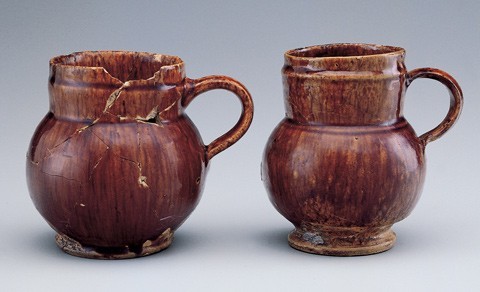
Mugs, Staffordshire, 1700–1720. Manganese-mottled earthenware. H. 3 7/8" and 4". Mugs of similar shape, referred to at the time as a “gorge,” were also produced in German and English stoneware, delftware, and metalware, in the late seventeenth and early eighteenth centuries. The mug on the left has a short angular foot that is unglazed, as is the flat circular base (save for slight glaze flooding). The mug is rather heavily potted. The mug on the right also has a spherical body smaller than the body of the foregoing mug. Likewise, its slightly flaring cylindrical neck is taller and narrower. There is a glaze flaw on the extremity of the body where it has touched against another vessel in the kiln. The flared foot is unglazed, as is the flat circular base. The mug has been professionally reconstructed and has two small areas of restoration.

Mug fragments, Staffordshire, 1700–1720. Manganese-mottled earthenware. Several other fragments of these gorge shaped mugs were recovered.
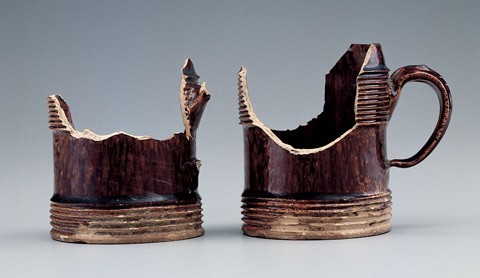
Mugs, Staffordshire, 1700–1720. Manganese-mottled earthenware. H. of right mug: 3 3/4". These two mugs have a half-pint capacity. Each has a cylindrical body with a slightly tapering cylindrical neck and a single shoulder-band formed by ten deep wheel-turned grooves. The partially glazed foot-band is formed by five deep wheel-turned grooves, and the flat circular base is unglazed. The mug on the right has a ribbed “ear” shaped handle with the upper junction at the shoulder-band and the lower junction just above the foot-band. The mug on the left lacks the handle, but the junctions are in the same position. Both mugs are by the same maker. A number of other fragments of similar mugs were also recovered.

Mugs, Staffordshire, 1700–1720. Manganese-mottled earthenware. H. 4" and 5 3/4". The base of the half-pint mug on the left displays numerous parallel straight, string-mark lines. The elongated ribbed loop handles attach at the shoulder-band and just above the foot-band. The lower junction shows a tightly thumbed terminal that has excess clay folded over and up. The body of the pint mug on the right is misshapen, where it was accidentally squashed between the handle junctions before firing. The partially glazed foot-bands have been formed by numerous wheel-turned grooves, and the flat, circular bases are unglazed. Both mugs were probably made by the same potter.
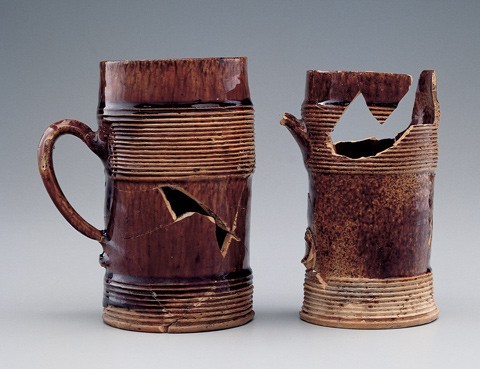
Mugs, Staffordshire, 1700–1720. Manganese-mottled earthenware. H. 5 3/4" and 5 1/2". The mug on the left shows the reverse of the mug illustrated in fig. 20 (right). The mug on the right has a cylindrical body, slightly tapering cylindrical neck, and a single shoulder-band formed by numerous wheel-turned grooves. The unglazed, flared foot-band is also formed by numerous wheel-turned grooves, and the flat, circular base is unglazed. The same potter possibly made this and the two mugs illustrated in fig. 20.
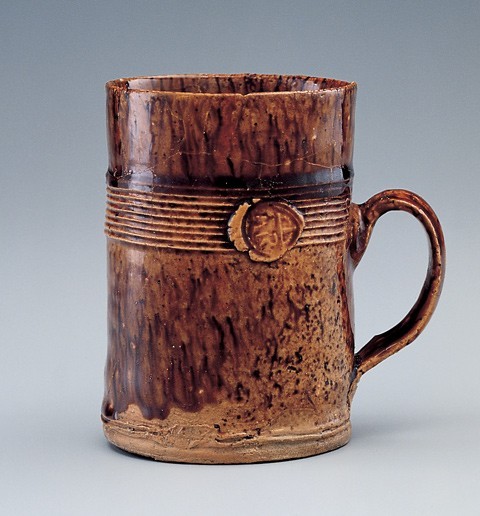
Mug, Staffordshire, 1702– 1714. Manganese-mottled earthenware. H. 3 7/8". This half-pint mug’s cylindrical body has a single shoulder-band formed by numerous wheel-turned grooves. The shoulder-band incorporates an applied clay pad stamped with a crowned “AR” ale-measure mark with relief details. The elongated ribbed loop handle attaches at the lower part of the shoulder-band and just above the narrow, mainly unglazed, foot-band. The unglazed flat, circular base has clay adhesions from another vessel or kiln furniture. The mug has been professionally reconstructed, with only minor restoration.
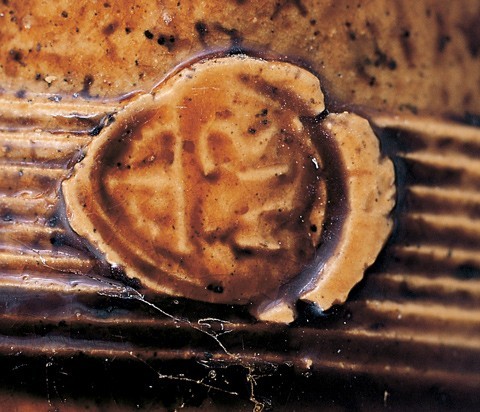
Detail of the “AR” excise mark on the mug illustrated in fig. 22.

Mugs, Staffordshire, 1700–1720. Manganese-mottled earthenware. The mottled-ware mug on the left was excavated in Town Road, Hanley, Stoke-on-Trent, and is shown for comparison with the mug illustrated in fig. 22.
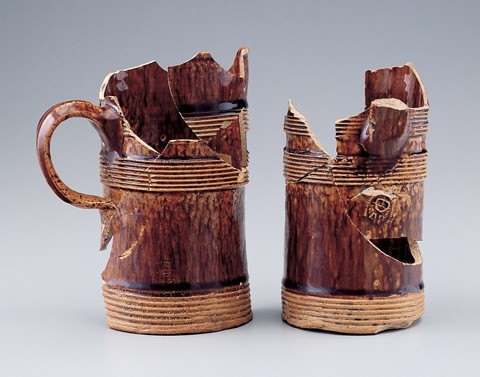
Mugs, Staffordshire, 1702– 1714. Manganese-mottled earthenware. H. (left) 5 3/4". The half-pint mug on the left shows a narrow, raised band around the rim with an underlying groove about 1/8 inch below. The double shoulder-bands and the unglazed foot-bands were formed by numerous wheel-turned grooves, and the flat, circular bases are unglazed. The handle’s lower junction is stamped with a crowned “AR” ale- measure mark. The same potter made both mugs, although the “AR” marks
are different.

Detail of the “AR” mark on the mug illustrated on the left in fig. 25.
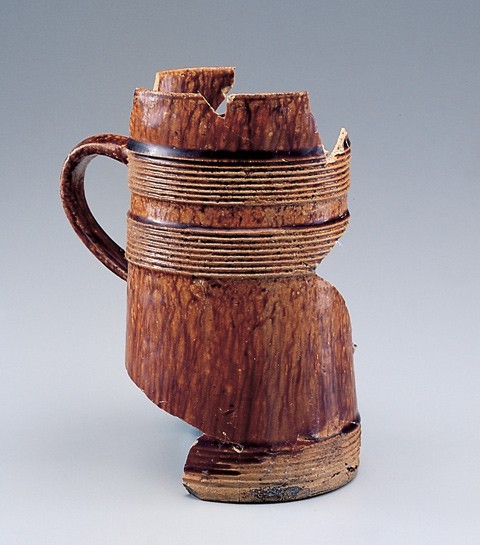
Mug, Staffordshire, 1702–1714. Manganese-mottled earthenware. H. 6 5/8". This quart sized mug is very similar to the smaller pint mugs illustrated in fig. 25 and probably was thrown by the same potter. It is stamped with a crowned “AR” ale-measure mark.
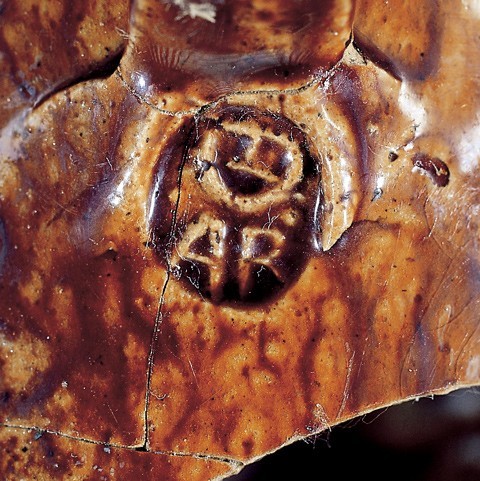
Detail of the “AR” mark on the mug illustrated in fig. 27.
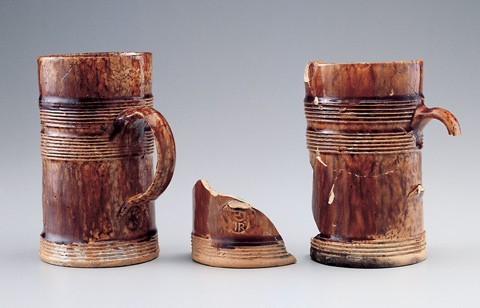
Mugs, Staffordshire, 1700–1720. Manganese-mottled earthenware. H. 5 1/2" and 5 1/4". The two nearly complete pint mugs display a double shoulder-band and an unglazed foot-band formed by numerous wheel-turned grooves. One mug (left) handle’s lower junction is stamped with an indistinct crowned “AR” ale-measure mark terminal with relief details. The same stamped terminal appears on the mug fragment (center). The mug on the left has been professionally reconstructed.
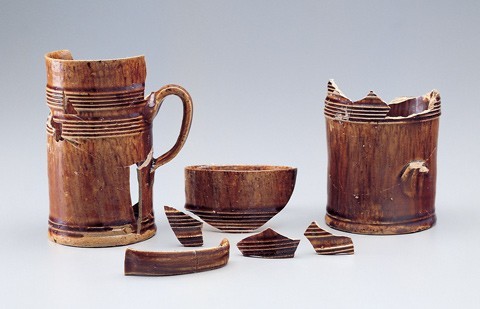
Mugs, Stafffordshire, 1700–1720. Manganese-mottled earthenware. H. (left) 5 1/8". Each of these pint mugs has a cylindrical body and a double shoulder-band formed by numerous wheel-turned grooves.
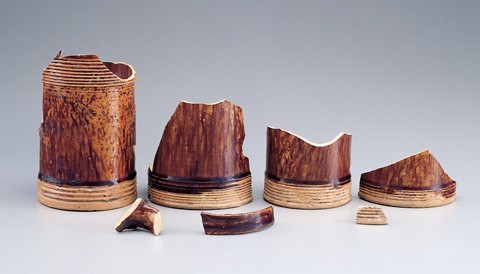
Mug fragments, Staffordshire, 1700–1720. Manganese-mottled earthenware. H. (left) 5 3/4". Each of these fragments of four mugs has a cylindrical body and an unglazed foot-band formed by numerous wheel-turned grooves.

Mugs, Staffordshire, 1700–1720. Manganese-mottled earthenware. D. (left) 3 5/8". Each of these fragments of four mugs has a cylindrical body and a glazed foot-band formed by numerous wheel-turned grooves.
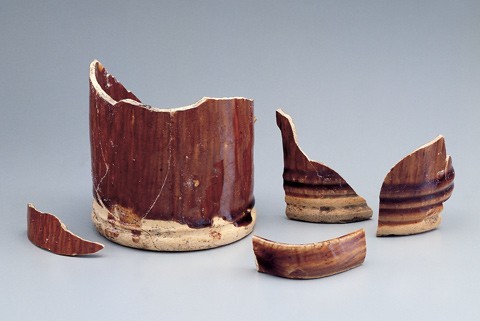
Mug fragments, Staffordshire, 1700–1720. Manganese-mottled earthenware. D. of base: 3 1/8". The base fragment has an unglazed rounded foot displaying a single wheel-turned groove. The flat, circular base is unglazed.
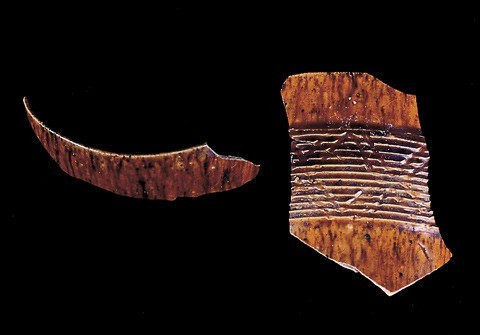
Mug fragments, Staffordshire, 1700–1720. Manganese-mottled earthenware. The rim fragment on the left is from a thinly potted mug being 1/16" to 3/32" thick and has a mottled olive-brown glaze. The fabric is a high-fired gray earthenware, which does not appear to correspond with any of the other recovered “mottled” wares from the Talbot Hotel. The fragment on the right has a shoulder-band formed by numerous wheel-turned grooves that are additionally hand-incised with linked double-lined saltire crosses.
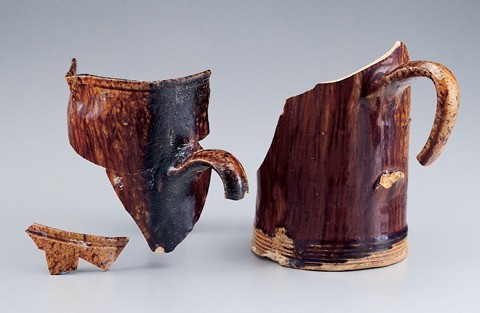
Jug fragments, Staffordshire, 1700–1720. Manganese-mottled earthenware. D. of base: 3 3/4". One jug (left) has a neck with a lip-pinch and a single groove running about ‹÷¡§ inches below the rim. A section of its elongated loop handle is set at ninety degrees to the lip-pinch. The second jug has a section of an elongated loop handle matching the handle of the first, and the handle’s upper junction is assumed to be in a similar position. The flat, circular base is unglazed.
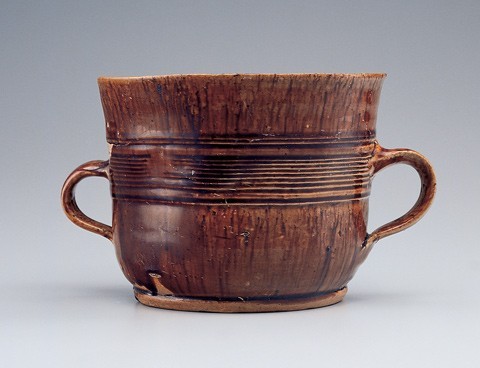
Cup, Staffordshire, 1700–1720. Manganese-mottled earthenware. H. 5". This large cup has a rounded body with a widely flared cylindrical neck above a wide shoulder-band formed by numerous wheel-turned grooves, and incorporating a prominent cordon near the top and bottom. The short, angular foot is partially glazed, whereas the flat, circular base is unglazed. The fabric is grayish-buff earthenware. The glaze shows scratching and wear, particularly on the interior.
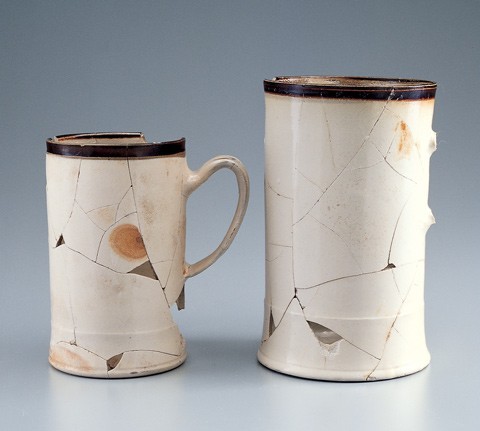
Mugs, Staffordshire, ca. 1720. Salt-glazed stoneware. H. 5 1/8" and 6 5/8". These white dipped mugs have the addition of an iron-rich slip around the rim. Both mugs have areas of iron contamination, and the quart mug (right) has small areas of the white pipe-clay slip pulling away just below the rim interior.
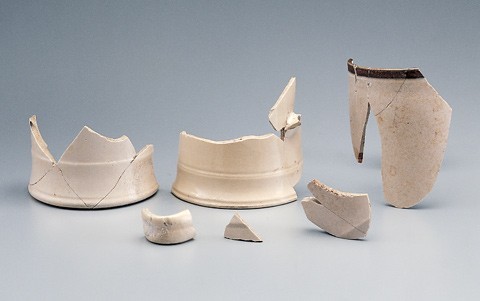
Mug fragments, Staffordshire, ca. 1720. Salt-glazed stoneware.
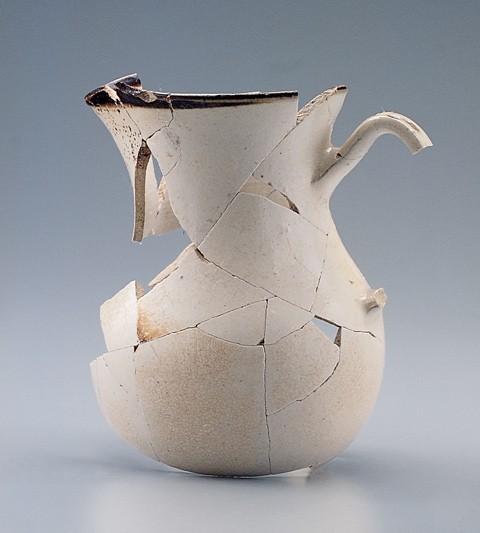
Jug, Staffordshire, 1700– 1720. Salt-glazed stoneware. H. 5 1/2". The spherical body has a flared neck, pinched lip, and band of iron-rich slip around the rim. A similar excavated jug is in the Potteries Museum and Art Gallery, Stoke-on-Trent, and at Rummey’s Tavern in London Town, Maryland.
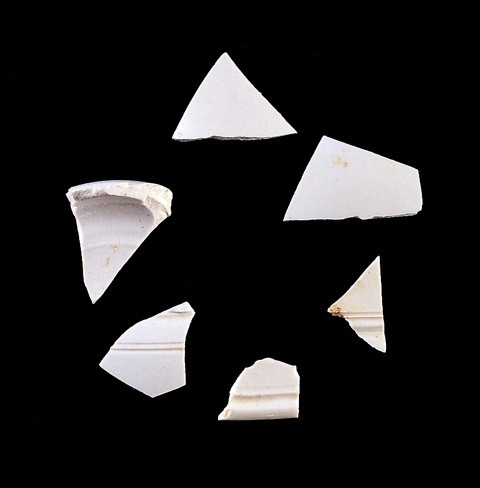
Fragments, Staffordshire, ca. 1725. Salt-glazed stoneware. These small fragments represent one or more vessels including a base fragment and a rim fragment, with wheel-turned grooved banding.
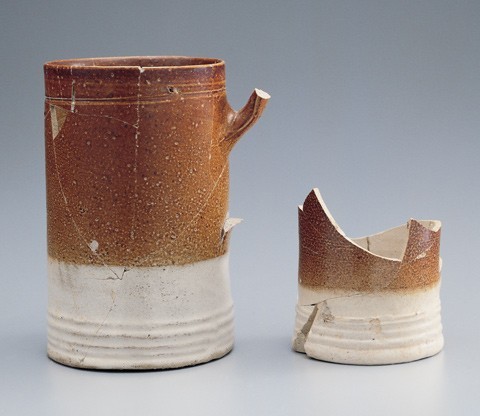
Mugs, Staffordshire, 1700– 1720. Salt-glazed stoneware. H. 5". The pint mug on the left has a foot-band formed by four wheel-turned cordons above a rounded foot-rim. The lower part of the pint has an off-white pipe-clay slip dip on the exterior, over a pale gray fabric, and there are areas of slip on the slightly concave base where the slip has run from the foot-rim. The upper part of the pint mug has a freckled iron-rich dip that also continues down from the rim on the interior about 3/4 inch (1.9 cm.) and on the remaining sections of the grooved handle. The half-pint mug on the right has a white-slip dip on the interior, on the lower part of the exterior and over the base. Both mugs are probably by the same maker. These mugs were included in Jonathan Horne’s 1985 Exhibition of English Brown Stoneware, in Kensington Church Street, London. Similar mugs were recovered from Swan Bank, Burslem.

Mugs, England, ca. 1710. Salt-glazed stoneware. H. 7" and 6 1/2". The quart mug on the left was probably made in Nottingham and has an impressed circular ale-measure mark below the wide band, with the uncrowned conjoined initials “AR” in relief. The mug on the right was possibly made in Bristol. The pale gray fabric has a freckled iron-rich dip overall. These mugs were included in Jonathan Horne’s 1985 Exhibition of English Brown Stoneware, in Kensington Church Street, London.

Detail of the impressed “AR” on the mug illustrated on the left in fig. 42.
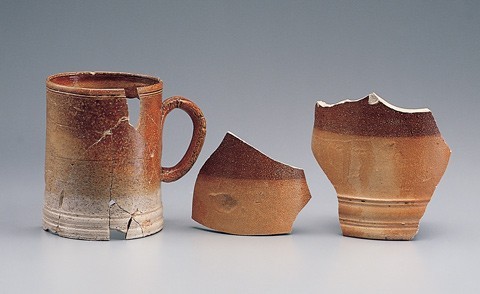
Mug and mug fragments. Salt-glazed stoneware. Left: Possibly Bristol, H. 3 3/4". The top three-quarters of the exterior of the mug, including the handle, has a freckled iron-rich dip over the pale gray stoneware fabric. The interior is partially wiped in dark brown. This mug was included in Jonathan Horne’s 1985 Exhibition of English Brown Stoneware, in Kensington Church Street, London. Right: Two large fragments of a Staffordshire mug, one fragment with a foot-band formed by a central cordon between wheel-turned grooves, above a rounded foot-rim. A white-slip dip over the pale gray fabric and the overall freckled iron-rich dip on the exterior is divided into two distinct tones by the white-slip base dip.
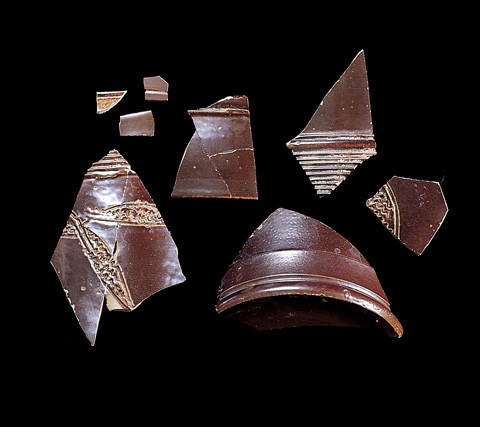
Mug fragments, Staffordshire, ca. 1710. Stoneware with a solid lustrous iron-rich dip on the exterior, matt mid-brown overall on the interior. The banded decoration is formed by wheel-turned grooves, and the incised stylized foliage has a zigzag infill. The base fragment has a wheel-turned, slightly waisted raised foot-band, a rounded foot-rim, and a partially recessed circular base. A similarly decorated mug was excavated near St. John’s Church, Burslem, in 1964. Another was recovered from the Wellfleet Tavern, at Wellfleet, Great Island, Massachusetts.
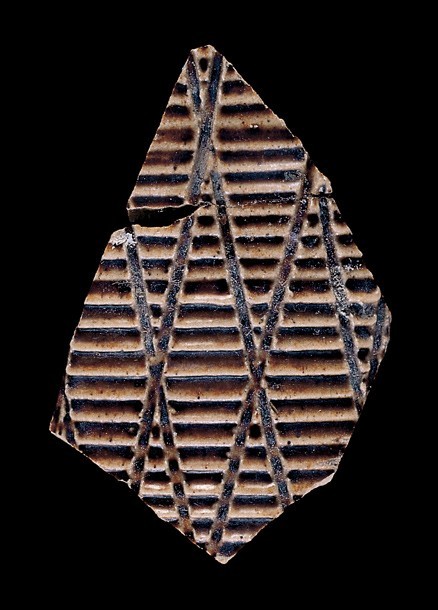
Mug fragment, probably Staffordshire, ca. 1710. This fragment exhibits a mid-brown, iron-rich dip on the exterior and interior. The ground decoration of numerous parallel wheel-turned grooves is hand-incised with straight lines to form an elongated diamond diaper pattern. Other fragments of this type of ware were recovered including one with an impressed partial ale-measure mark that includes the top of a raised unidentifiable royal initial.

Cups, Staffordshire, 1700. Slipware. H. 2 7/8" and 2 3/4". The cup on the left has a reddish-pink earthenware fabric displaying a white-slip coating. Its exterior is finely combed. The cup on the right has a pale buff earthenware fabric displaying an iron-rich slip coating on the exterior and a white slip coating on the interior. The exterior is trailed in white slip with five stylized vertical leaves, each central vein combed to produce numerous fronds. The slightly concave base is unglazed save for slight glaze flooding. Both cups have been professionally reconstructed and have areas of restoration. A Staffordshire mottled ware cup of similar shape was recovered from the Talbot Hotel site (see fig. 16). Similar cups were recovered from a workman’s trench at the present-day Sadler’s factory in Burslem.
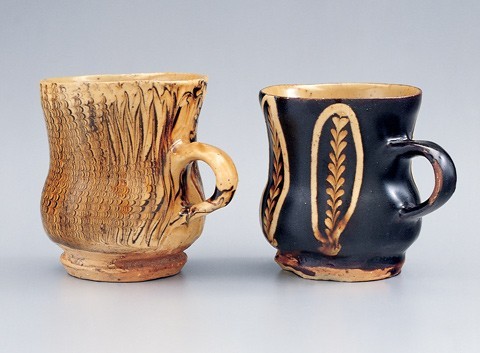
Cups, Staffordshire, 1700. Slipware. H. 2 7/8" and 2 3/4". The cup on the left has a reddish-pink earthenware fabric displaying a white-slip coating. Its exterior is finely combed. The cup on the right has a pale buff earthenware fabric displaying an iron-rich slip coating on the exterior and a white slip coating on the interior. The exterior is trailed in white slip with five stylized vertical leaves, each central vein combed to produce numerous fronds. The slightly concave base is unglazed save for slight glaze flooding. Both cups have been professionally reconstructed and have areas of restoration. A Staffordshire mottled ware cup of similar shape was recovered from the Talbot Hotel site (see fig. 16). Similar cups were recovered from a workman’s trench at the present-day Sadler’s factory in Burslem.
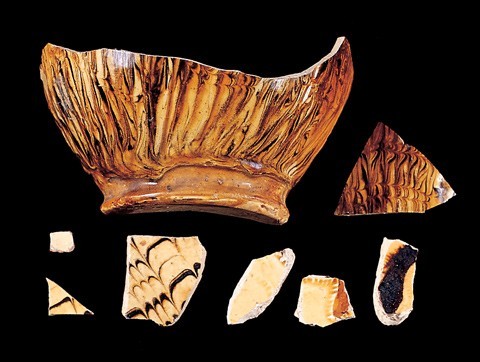
Slipware fragments, Staffordshire, 1700–1720. D. of base fragment: 3 1/4". The largest fragment represents a cup, or honey pot, with a spherical body and a rounded, angular foot-rim. The pale buff earthenware fabric displays an exterior white-slip coating vertically striped in dark-brown slip with traces of horizontal combing. The small fragments include two dish fragments (bottom left) with combed decoration; three fragments (bottom right) from a press-molded dish, or dishes, with traces of a mid-brown slip infill; and a tiny vessel fragment (left).
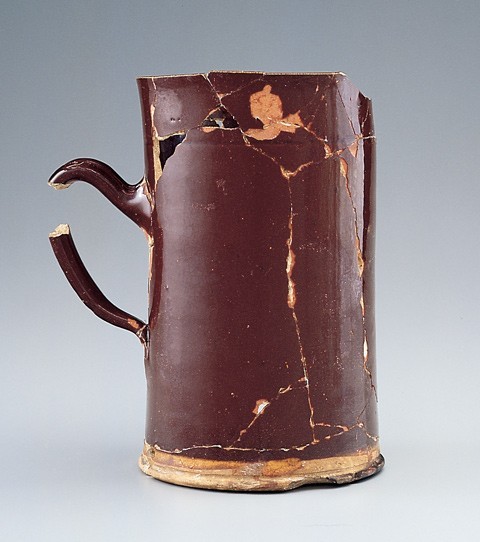
Mug, probably Staffordshire, England, ca. 1720. Slip-coated earthenware. H. 6 3/4". This quart capacity mug has a tall, cylindrical body with a single wheel-turned groove below the slightly flared rim. The wheel-turned, double-grooved foot-band and the rounded, angular foot-rim are unglazed except for slight glaze flooding. The lead glaze has transformed the slip-coat to a solid dark, reddish-brown color, and the glaze appears translucent yellow where it has flooded over the slip-free foot-band.

Mug, probably Staffordshire, England, ca. 1720. Slip-coated earthenware. H. 6 3/4". This quart capacity mug has a tall, cylindrical body with a single wheel-turned groove below the slightly flared rim. The wheel-turned, double-grooved foot-band and the rounded, angular foot-rim are unglazed except for slight glaze flooding. The lead glaze has transformed the slip-coat to a solid dark, reddish-brown color, and the glaze appears translucent yellow where it has flooded over the slip-free foot-band.
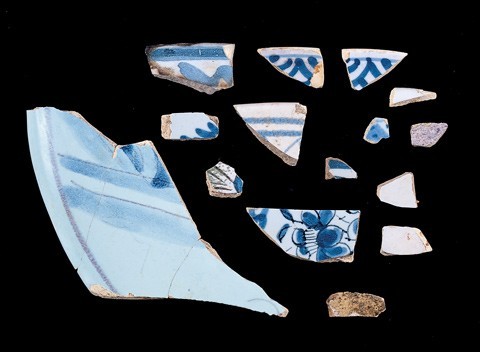
Plate and bowl fragments, England, 1700–1720. Tin-glazed earthenware. The large dish fragment is attributed to Brislington having a plain, shallow, rounded form and a matt, duck-egg blue, tin-glazed ground over a pale buff fabric. The indistinguishable decoration is washed in tones of blue and is delineated in manganese. The majority of the other fragments are attributed to Bristol and painted in blue and, most likely, belong to plates or dishes. The exceptions are a blue-painted fragment from a possible bowl rim; one fragment from a possible drinking vessel, displaying powdered manganese-purple on both interior and exterior; and one fragment with polychrome decoration painted in blue, sponged in green, and delineated in black.
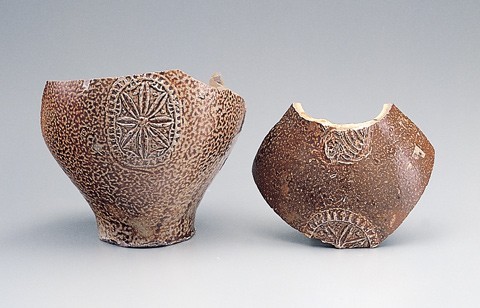
Fragments of two bottles, Germany, ca. 1680. Salt-glazed stoneware. Each of these fragments of Bellarmine bottles have an ovoid body and a freckled, iron-rich exterior dip over a pale gray stoneware fabric. The bottles have a slightly varying oval, relief-molded, rosette medallion applied to the front.
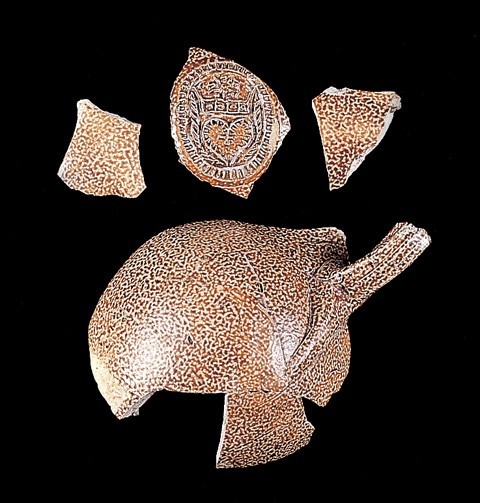
Fragments of Bellarmine bottles, Germany, ca. 1680. Salt-glazed stoneware. One fragment’s applied relief-molded, oval medallion depicts a heart encircling a cross beneath a crown. Another fragment (not pictured) displays part of an applied relief-molded medallion, including the initial “H.” Similar initialed medallions were found on bottles made at John Dwight’s factory in Fulham, London. However, the fragment noted does not correspond with any known Dwight examples.

Detail of the heart medallion illustrated in fig. 52.
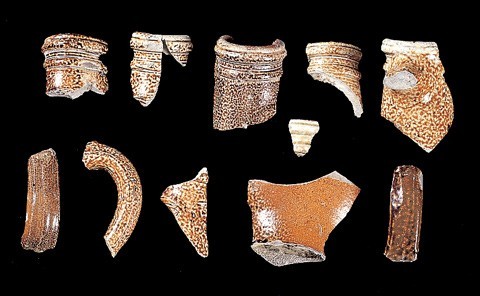
Bottle fragments, Germany, ca. 1680. Salt-glazed stoneware. These various neck, handle, and base fragments may belong to the bottles previously discussed.
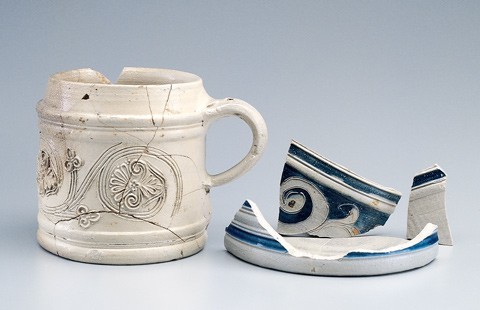
Mug and mug fragments, Westerwald, Germany, 1690–1710. Salt-glazed stoneware. H. 3 3/8". The nearly complete example on the left has a loop handle that has an indentation at the top for a metal cover. The stoneware fabric is pale gray, and the base is flat. The mug fragments on the right are incised with foliate scrollwork and display a cobalt-blue background wash.
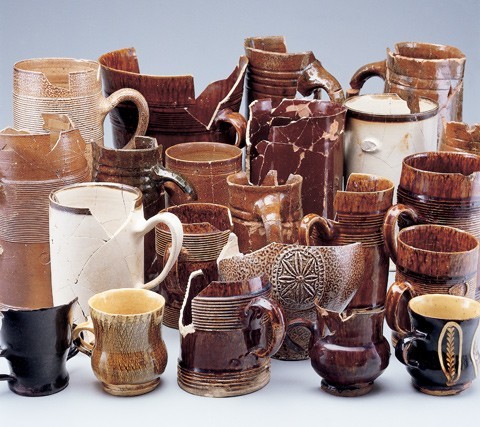
Overall view of reconstructed vessels from the Talbot Hotel assemblage.
